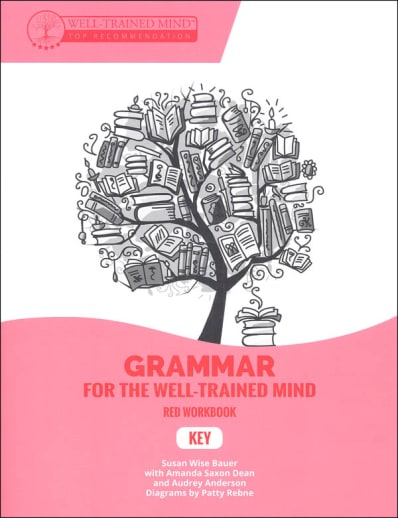Answers to the student exercises are provided in the Student Workbook Answer Key which contains exercises with answers as well as detailed notes that explain/clarify answers. Students are encouraged to check their own work and discuss any discrepancies.
Grammar for The Well-Trained Mind: Red Workbook Key
Description
Contains the following components of the Grammar For the Well-Trained Mind Curriculum. If you already own the Instructor Text, and just need the student material for the Red Books, this is the bundle for you.
Workbook: The first of a four-book series, the Red Workbook provides detailed exercises in the correct use of English grammar, based on great works of literature as well as classic and contemporary works of science and history. Future Workbooks will contain the same rules and examples"but completely different sets of exercises, allowing students to develop a wide-ranging knowledge of how the rules and examples are used in writing.
Answer Key for Red Workbook: The Answer Key provides clear answers and explanations for the parent/instructor.
Instructor Text sold separately. The Instructor Text is necessary for teaching with the Workbook and Key.
Grammar for the Well-Trained Mind covers and builds mastery in all aspects of the English language for those willing to devote the necessary time and energy. It is Susan Wise Bauer’s sequel to First Language Lessons for the Well-Trained Mind. Following the classical approach, this course builds a pattern of teaching rules and definitions (in Grammar, Usage, and Mechanics), with identifying, diagramming (over 400 exercises per book), and practicing all levels of grammar. The exercises use real-world model sentences from published authors (with a strong emphasis on timeless literature). These reading passages are accessible and challenging, but also exemplify good writing.
It’s assumed that students will imperfectly grasp concepts at first, but through repeating exercises, concepts will be mastered as they continually apply the skills. Instruction is done through teacher-student dialogues—requiring a teacher investment (probably 15-20 minutes per lesson). The teacher material, however, is scripted with little to no prep needed. Lesson expectation is approximately 4 days/week for 36 weeks; many students will need to slow down the pace, particularly in the book’s second half. Grammar concepts are presented, rules taught, and the provided examples discussed. Then, students practice concepts. The individual exercises vary: some underlining, labeling, diagramming, and some construction of new sentences, etc. Students are encouraged to check their own work and discuss any discrepancies. After every 3 weeks, a Student Review provides a “brush up” of each lesson’s key grammar concept. Starting at Review 9, schedule one week to complete the reviews. In these review weeks, aim to complete 3 exercises daily. After week 27, the number of reviews double. During review, note any concepts missed to encourage future success. The course ends with a final review.
There are four non-sequential courses: Red, Purple, Blue, and Yellow. Each level follows the same progression: Lessons 1-40 cover basic grammar. Starting at week 19, students should read sentences out loud. Then, Lessons 41-80 cover Intermediate grammar and Lessons 81-130, Advanced. Grammar mastery is based on four years of progression—although the pace will vary as the student improves in skill. Each workbook teaches the same grammar concepts in the same order, yet each provides completely new sentences and passages with which to practice and engage. A key concept with this 4-year method is simultaneously providing review of grammar concepts yet applying them to new material: the goal is English language competence. Courses can be started with any color, although Ms. Bauer generally suggests starting with red. While annual repetition is the intent, you have the freedom to choose how to complete the 4-year sequence. You could make the course a tighter spiral by completing the lessons in one color by skill level (such as basic grammar, lessons 1-40) and then choosing the next color to review those same lessons. If you have multiple students, you could also have each student use a different color while teaching the same concepts simultaneously. If your student has not had grammar study, one level could be used as a 9th grade grammar.
For each of the 4 years, you’ll need the Core Instructor Text (which provides the question/answer dialogues for 130 lessons); the Grammar Guidebook (a condensed handbook with grammar rules explained). Then, for each year, you’ll select a color level with the corresponding consumable Student Workbook (which provides all student exercises, grammar rules, definitions, information, and sample sentences) and the Student Workbook Answer Key (answers with detailed explanatory notes). For each level, convenience sets are available that include the consumable student workbook and the answer key.
You may find 2 companion books helpful in guiding your student. First, The Diagramming Dictionary Reference Guide (80 pgs, hardcover) illustrates diagramming rules, from simple to complex. These diagrams are easy to understand and color-coded. In conjunction, use the How to Diagram Any Sentence (128 pgs, pb) to practice concepts presented in the guide. In conjunction, these two resources will assist in strengthening grammar writing skills—whether as part of a separate composition course, to teach diagramming, or to help you as teacher in your understanding as you teach Grammar for the Well-Trained Mind course. The sentences presented and practiced in these companion books are drawn from the four course levels. The Grammar Guidebook 95 pgs, hardcover. Core Instructor Text 387 pgs, paperback. Individual Student Workbooks 579-632 pgs, paperback. Answer Key 417-488 pgs, paperback. ~ Ruth
| Product Format: | Paperback |
|---|---|
| Grades: | 5-8 |
| Brand: | Well-Trained Mind Press |
| Author: | Susan Wise Bauer |
| ISBN: | 9781945841279 |
| Length in Inches: | 11 |
| Width in Inches: | 8.5 |
| Height in Inches: | 1.125 |
| Weight in Pounds: | 2.4 |

